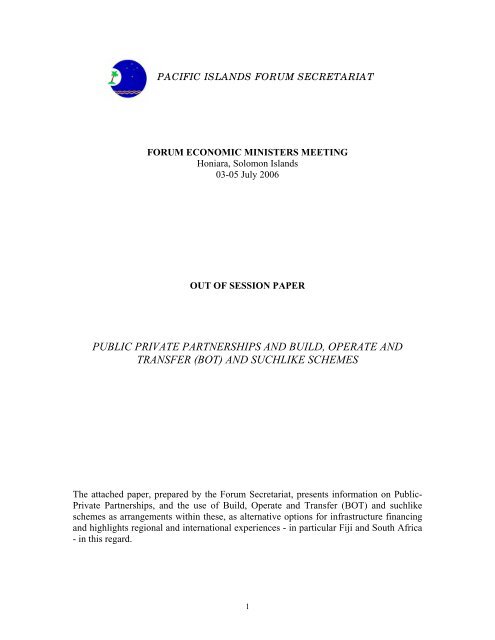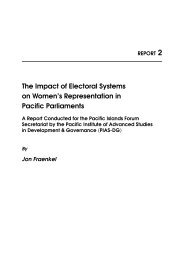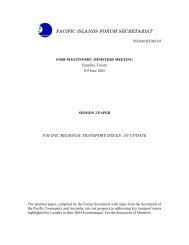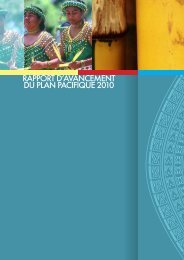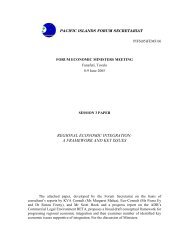PUBLIC PRIVATE PARTNERSHIPS AND BUILD, OPERATE AND TRANSFER (BOT ...
PUBLIC PRIVATE PARTNERSHIPS AND BUILD, OPERATE AND TRANSFER (BOT ...
PUBLIC PRIVATE PARTNERSHIPS AND BUILD, OPERATE AND TRANSFER (BOT ...
You also want an ePaper? Increase the reach of your titles
YUMPU automatically turns print PDFs into web optimized ePapers that Google loves.
PACIFIC ISL<strong>AND</strong>S FORUM SECRETARIAT<br />
FORUM ECONOMIC MINISTERS MEETING<br />
Honiara, Solomon Islands<br />
03-05 July 2006<br />
OUT OF SESSION PAPER<br />
<strong>PUBLIC</strong> <strong>PRIVATE</strong> <strong>PARTNERSHIPS</strong> <strong>AND</strong> <strong>BUILD</strong>, <strong>OPERATE</strong> <strong>AND</strong><br />
<strong>TRANSFER</strong> (<strong>BOT</strong>) <strong>AND</strong> SUCHLIKE SCHEMES<br />
The attached paper, prepared by the Forum Secretariat, presents information on Public-<br />
Private Partnerships, and the use of Build, Operate and Transfer (<strong>BOT</strong>) and suchlike<br />
schemes as arrangements within these, as alternative options for infrastructure financing<br />
and highlights regional and international experiences - in particular Fiji and South Africa<br />
- in this regard.<br />
1
PACIFIC ISL<strong>AND</strong>S FORUM SECRETARIAT<br />
FORUM ECONOMIC MINISTERS MEETING<br />
Honiara, Solomon Islands<br />
03-05 July 2006<br />
<strong>PUBLIC</strong> <strong>PRIVATE</strong> <strong>PARTNERSHIPS</strong> <strong>AND</strong> <strong>BUILD</strong>, <strong>OPERATE</strong> <strong>AND</strong><br />
<strong>TRANSFER</strong> (<strong>BOT</strong>) <strong>AND</strong> SUCHLIKE SCHEMES<br />
Purpose<br />
This paper presents information on Public-Private Partnerships, and the use of<br />
Build, Operate and Transfer (<strong>BOT</strong>) and suchlike schemes as arrangements within these,<br />
as alternative options for infrastructure financing and highlights regional and<br />
international experiences - in particular Fiji and South Africa - in this regard.<br />
Background<br />
2. At FEMM 2005, Ministers requested, amongst other things, that the Pacific<br />
Islands Forum Secretariat (PIFS) compile a set of case studies and practical experiences,<br />
from within and outside the region, for the information of members in the use of “Build,<br />
Operate and Transfer” (<strong>BOT</strong>)/“Build, Own, Operate and Transfer” (BOOT) and suchlike<br />
schemes.<br />
3. Given that <strong>BOT</strong>/BOOT schemes are designed and implemented as Public-Private<br />
Partnership (PPP) arrangements, the approach adopted in covering this issue has been to<br />
focus on <strong>BOT</strong>/BOOT schemes within the broader context rather than as a separate issue.<br />
Issues<br />
Public-Private Partnerships<br />
4. The private sector is playing an increasingly crucial role in the financing and<br />
provision of services that were traditionally the domain of the public sector. One of the<br />
key reasons is that governments are unable to cope with the ever-increasing demands on<br />
their budgets. Most infrastructure expenditures in developing countries have been funded<br />
directly from fiscal budgets but several factors such as macroeconomic instability and<br />
growing investment requirements have shown that public financing is volatile and, in<br />
many countries, rarely meet crucial infrastructure expenditure requirements in a timely<br />
and adequate manner. 1<br />
1 Ferreira and Khatami (1996)<br />
2
5. Furthermore, there are efficiency gains arising from innovation, management and<br />
marketing skills offered by the private sector and greater incentives for the control of<br />
construction, operating and maintenance costs. More so, the provision of additional<br />
finance for infrastructure projects enables projects to be brought forward in time, thus<br />
generating earlier economic benefits. 2<br />
6. The diagram below illustrates the continuum of options for involving the private<br />
sector in the provision of infrastructure delivery. 3<br />
Diagram 1: Range of Private Sector Options<br />
7. At the left are supply and service contracts, which tend to be of short duration and<br />
require less private commitment than the options higher in the continuum. The private<br />
contractor is not directly responsible for providing the service, but instead for performing<br />
specified tasks, such as supplying inputs, constructing works, maintaining facilities, or<br />
billing customers. At the left are the longer term arrangements which require significant<br />
private sector commitment.<br />
Options for PPP<br />
8. There is a range of options for involving private sector participation that vary with<br />
regards to ownership, operations and maintenance, financing, risk allocation and<br />
duration. A summary of these options can be viewed in Table 1.<br />
Table 1: Allocation of key responsibilities under the main private sector participation options<br />
Option Asset<br />
Ownership<br />
Operations<br />
and<br />
Maintenance<br />
Capital<br />
Investment<br />
Commercial<br />
Risk<br />
Duration<br />
Service Public Public and Public Public 1-2 years<br />
contract<br />
Private<br />
Management<br />
contract<br />
Public Private Public Public 3-5 years<br />
Lease Public Private Public Shared 8-15 years<br />
Concession Public Private Private Private 25-30 years<br />
2 Haley (1996)<br />
3 World Bank (1995)<br />
3
Option Asset<br />
Ownership<br />
Build<br />
Operate<br />
Transfer<br />
Divestiture<br />
Private and<br />
public<br />
Private or<br />
private and<br />
public<br />
Source: World Bank (1997)<br />
Service contract<br />
Operations<br />
and<br />
Maintenance<br />
Capital<br />
Investment<br />
Commercial<br />
Risk<br />
Private Private Private<br />
Duration<br />
20-30 years<br />
Private Private Private Indefinite<br />
(may be<br />
limited by<br />
license)<br />
9. Under this option, the private sector performs a specific operational service for a<br />
fee, for example meter reading, billing and collection.<br />
Management contract<br />
10. In this option, the private sector is paid a fee for operating and maintaining a<br />
government-owned business and making management decisions.<br />
Lease<br />
11. Under the lease option, the private sector leases facilities and is responsible for<br />
operation and maintenance.<br />
Concession<br />
12. Under concessions, the private sector finances the project and also has full<br />
responsibility for operations and maintenance. The government owns the asset and all full<br />
use rights must revert to the government after the specified period of time.<br />
Divestiture<br />
13. This option can take two forms – partial or complete divestiture. A complete<br />
divestiture, like a concession, gives the private sector full responsibility for operations,<br />
maintenance and investment, but unlike a concession, a divestiture transfers ownership of<br />
the assets to the private sector.<br />
14. Discussion on the build, operate and transfer (<strong>BOT</strong>) options is covered more fully<br />
in the next section.<br />
4
<strong>BOT</strong>/ BOOT Schemes<br />
15. The build, operate, transfer (<strong>BOT</strong>) approach has in recent years played a growing<br />
role in the implementation of industrial and infrastructure projects such as toll roads,<br />
water supply and treatment facilities in both industrialised and developing countries.<br />
They are designed and implemented as Public-Private Partnership (PPP) arrangements.<br />
16. In the FIC region, the need to develop and implement innovative project financing<br />
methods such as <strong>BOT</strong> is more pronounced given the costs of providing infrastructure<br />
services are naturally high. Small scale, dispersed populations, remoteness and<br />
susceptibility to natural disasters mean that “[Pacific countries] don’t benefit from the<br />
economies of scale infrastructure normally offers, services are often more costly to<br />
produce and maintain, and it is costly to increase access to rural areas”. 4<br />
What is <strong>BOT</strong>?<br />
17. <strong>BOT</strong> is the terminology for a model or structure that uses private investment to<br />
undertake the infrastructure development that has historically been undertaken by the<br />
public sector. 5 In a <strong>BOT</strong> project, a private company is given a concession to build and<br />
operate a facility that would normally be built and operated by the government. The<br />
private company is also responsible for financing and designing the project. At the end of<br />
the concession period, the private company returns ownership of the project to the<br />
government (although this need not be the case). The concession period is determined<br />
primarily by the length of time needed for the facility’s revenue stream to pay off the<br />
company’s debt and provide a reasonable rate of return for its effort and risk.<br />
Other types of <strong>BOT</strong><br />
18. The acronym <strong>BOT</strong> is often used interchangeably with BOOT or build-ownoperate-transfer.<br />
Variants include BOO (build-own-operate without any obligation to<br />
transfer); BT (build and transfer); BLT or BRT (build, rent or lease and transfer); BT<br />
(build and transfer immediately), BTO (build, transfer and operate) 6 , DBFO (design,<br />
build, finance and operate); and DCMF (design, construct, manage and finance); MOT<br />
(modernize, own/ operate and transfer); ROO (rehabilitate, own and operate); and ROT<br />
(rehabilitate, own and transfer).<br />
19. The table provided below reviews the <strong>BOT</strong> option and its variants, describes<br />
some characteristics of these different procurement arrangements and depicts the<br />
relationship between these different procurement methods and the financing of the<br />
project.<br />
4 Castalia (2005)<br />
5 UNIDO (1998)<br />
6 Possibly subject to installment payments of the purchase price.<br />
5
Table 2: <strong>BOT</strong> project procurement structures<br />
<strong>BOT</strong> Project Type Characteristics<br />
Build Own Operate Transfer (BOOT)<br />
• The service provider is responsible for<br />
design and construction, finance,<br />
operations, maintenance and commercial<br />
risks associated with the project.<br />
• The service provider owns the project<br />
throughout the concession period<br />
• The asset is transferred back to the<br />
government at the end of the term, often at<br />
no cost.<br />
Build Own Operate (BOO)<br />
Design Build Operate (DBO)<br />
Lease Own Operate (LOO)<br />
Source: Arndt (1999)<br />
• Similar to BOOT projects, but the service<br />
provider retains ownership of the asset in<br />
perpetuity.<br />
• The government only agrees to purchase<br />
the services produced for a fixed length of<br />
time<br />
• A design and construction contract linked<br />
to an operation and maintenance contract.<br />
• The service provider is usually responsible<br />
for financing the project during<br />
construction.<br />
• The government purchases the asset from<br />
the developer for a pre-agreed price prior<br />
to (or immediately after) commissioning<br />
and takes all ownership risks from that<br />
time.<br />
• Similar to a BOO project but an existing<br />
asset is leased from the government for a<br />
specified time.<br />
• The asset may require refurbishment or<br />
expansion.<br />
20. In a <strong>BOT</strong> project, the host government decides on the need for the project and its<br />
scope, requires that the design, performance and maintenance of the project be tailored to<br />
the country’s objectives and selects the private company by means of an appropriate<br />
bidding or evaluation process in order to arrive at a price that is fair to both the host<br />
government and the company.<br />
21. <strong>BOT</strong> projects, when properly designed, offer significant potential for technology<br />
transfer and local capacity building as well as helping develop national capital markets.<br />
6
Advantages and Challenges of the <strong>BOT</strong> Approach<br />
22. The <strong>BOT</strong> approach has many potential advantages, some of which have been<br />
alluded to above, and is a visible alternative in most countries to the more traditional<br />
approach using sovereign borrowings or budgetary resources. These are captured in the<br />
box provided below.<br />
Box 1: Potential advantages to the host government of using the <strong>BOT</strong> approach<br />
� Use of private sector financing to provide new sources of capital, which reduces public<br />
borrowing and direct spending and which may improve the host government’s credit rating.<br />
� Ability to accelerate the development of projects that would otherwise have to wait for, and<br />
compete, for sovereign resources.<br />
� Use of private sector capital, initiative and know-how to reduce project construction costs,<br />
shorten schedules and improve operating efficiency.<br />
� Allocation to the private sector of project risk and burden that would otherwise have to be<br />
borne by the public sector.<br />
� The involvement of private sponsors and experienced commercial lenders, which ensures an<br />
in-depth review and is an additional sign of project feasibility.<br />
� Technology transfer, the training of local personnel and the development of national capital<br />
markets.<br />
� In contrast to privitisation, government retention of strategic control over the project, which is<br />
transferred to the public at the end of the contract period.<br />
� The opportunity to establish a private benchmark against which the efficiency of similar<br />
public sector projects can be measured and the associated opportunity to enhance public<br />
management of infrastructure facilities.<br />
Source: UNIDO (1998)<br />
23. Some challenges that should be taken into consideration include the length of time<br />
required to develop and negotiate <strong>BOT</strong> schemes, the need for a suitable political and<br />
economic climate, and a defined regulatory environment. In short, the <strong>BOT</strong> approach<br />
requires an environment that is conducive to private sector investment.<br />
24. The economic costs associated with <strong>BOT</strong> projects include the following:<br />
• Costs due to imbalance in experience. Governments with little experience in <strong>BOT</strong><br />
contracts are advised to initiate <strong>BOT</strong> projects on a manageable scale and seek<br />
professional advice to compensate the often greater experience of the private<br />
sector.<br />
7
• User costs imposed for the first time or increased to match market rates. The<br />
economic costs of public services, once covered by the Government, then become<br />
financial costs for the user.<br />
• Overpriced supplies. Potential conflicts of interest on pricing among the project<br />
sponsors must be monitored. Care must be taken to ensure that sponsors who<br />
supply goods or services to the project do so on a fully competitive basis.<br />
• High financing costs. Financing costs for <strong>BOT</strong> projects tend to be high, as the<br />
legal fees associated with their contractual arrangements are much higher than<br />
those of standard commercial contracts. The complexity of the credit means that<br />
lenders need more time than usual to assess a project’s merits and will tend to<br />
charge higher fees.<br />
25. Given the importance of infrastructure investment to national development it is<br />
essential that the wider socio-economic costs and benefits associated with a <strong>BOT</strong> scheme<br />
are taken into account when designing the legal framework to promote private sector<br />
investment in such projects.<br />
Box 2: Bringing water to all consumers in Chengdu, China<br />
The Chengdu Water Supply project involved the construction of a treatment plant and the establishment of<br />
a 27 kilometer transmission line to provide the population of Chengdu, an industrial city in southwest<br />
China, with an additional supply of 400, 00 cubic meters of treated water daily. Prior to this, urban water<br />
supply projects were funded by central or municipal governments, on a grant basis. Insufficient government<br />
funding meant that water shortages occurred, particularly in rapidly growing metropolitan areas. As the first<br />
<strong>BOT</strong> water supply project in PRC, the Chengdu Project demonstrated that this approach can be successfully<br />
implemented at the municipal level, and externally financed without government guarantee. ADB’s private<br />
sector operations extended a direct loan of $26.5 million for the project, and through ADB’s<br />
complementary financing scheme, ADB made possible commercial debt funding of $21.5 million.<br />
Source: ADB (2004)<br />
Case Study : Fiji’s PPP Policy 7<br />
26. The Fiji Government recognises that PPP is a good solution to its continual search<br />
for better value for money and better ways of delivering public infrastructure and related<br />
services. Government endorsed its PPP policy on 21 July 2001. 8<br />
27. Fiji’s economy is now sufficiently developed and matured to sustain PPPs. This<br />
is particularly so in view of the following:<br />
7 Information for the case study has been compiled in consultation with the Ministry of Public Enterprise<br />
and Public Sector Reform, Government of the Fiji Islands<br />
8 Cabinet Decision 315/ 2005<br />
8
� Fiji has an open and competitive economy. Various reforms are being pursued in<br />
civil service, financial management, and public enterprises. This will all contribute to<br />
competitiveness for Fiji economy, thus adding stimulus to PPP;<br />
� there is a medium to long-term pipeline of projects, which could be subjected to PPP;<br />
and<br />
� an institutional regulatory and legal framework to promote PPP projects is being<br />
developed.<br />
Current Government Policy<br />
28. A key priority of the Fiji Government is to raise the annual level of investment to<br />
at least twenty-five percent of gross domestic product. It intends to achieve this goal by<br />
increasing public investment – particularly in physical infrastructure and human capital –<br />
and by stimulating and facilitating higher levels of private investment.<br />
29. Furthermore, one of the Strategic Priorities of Fiji’s Strategic Development Plan<br />
(SDP 2003-2005) is “Structural reforms to promote competition and efficiency”. Public<br />
Private Partnerships or PPPs are an appropriate solution to this priority as well as the<br />
Governments continual search for better value for money and better ways of delivering<br />
public infrastructure and related services.<br />
Scope of Public Private Partnerships<br />
30. A PPP is an arrangement between the public and private sectors (consistent with a<br />
broad range of possible partnership structures) with clear agreement on shared objectives<br />
for the delivery of public infrastructure and/or public services by the private sector that<br />
would otherwise have been provided through traditional public sector procurement.<br />
31. A particular arrangement or project may constitute a PPP where the following key<br />
objectives have been met:<br />
(i) Better value for money and optimal allocation of risk, for example, by<br />
exploiting private sector competencies (managerial, technical, financial<br />
and innovation) over the project’s lifetime and by promoting the crosstransfer<br />
of skills between the public and private partners;<br />
(ii) Shared responsibility for the provision of the infrastructure or services<br />
with a significant level of risk being taken by the private sector, for<br />
example, in infrastructure projects linking design and construction with<br />
one or all of the finance, operate and maintain elements; and<br />
(iii) Encourage and promote resource owners participation in infrastructure<br />
development.<br />
32. There is a clear distinction between a PPP arrangement under which the private<br />
sector partner supplies public infrastructure and public services on behalf of the state for<br />
the contract period and the sale (i.e. privatisation) to the market sector of specific state<br />
assets. This policy reflects the former arrangement and is not regarded as being<br />
privatisation.<br />
9
33. In Fiji’s case, the PPP arrangements will be formed through competitive, open,<br />
public bidding in order to achieve the stated key objectives mentioned above.<br />
Goals and Benefits of Public Private Partnerships<br />
34. Identification of the goals of PPP and the prospective benefits from individual<br />
projects provide more certainty, in particular, for those (e.g. local communities) whom<br />
PPP projects are expected to serve. These goals and benefits include the following:<br />
(i) Speedy, efficient and cost-effective delivery of projects;<br />
(ii) Creation of added value through synergies between public sector and<br />
private sector, in particular, through the integration and cross-transfer of<br />
public and private sector skills, knowledge and expertise;<br />
(iii) Alleviation of capacity constraints and bottlenecks in the economy<br />
through higher productivity of labour and capital resources in the delivery<br />
of projects;<br />
(iv) Competition and greater construction capacity (including the participation<br />
of overseas firms – especially in joint ventures and partnering<br />
arrangements);<br />
(v) Accountability for the provision and delivery of quality public services;<br />
(vi) Innovation and diversity in the provision of public services; and<br />
(vii) Effective utilisation of state assets to the benefit of all users of public<br />
services.<br />
Statement of Principles<br />
35. The fundamental principles determining a PPP policy have emerged from<br />
consultation with key stakeholders in the public and private sectors.<br />
36. These key principles, summarised in the following section, are the foundation for<br />
this policy framework and are central to the achievement of the goals and objectives<br />
mentioned above including the establishment of sustainable partnerships in the<br />
development of Fiji's PPP programme. These key principles have been approved by<br />
Cabinet will be embodied in the enabling legislation for PPP.<br />
Principle 1: PPPs will be progressed within the context of national policy<br />
37. The SDP sets out national priorities relating to the timely and cost-effective<br />
delivery of economic and social infrastructure priorities and quality public services:<br />
(i) Structural reform to promote completion and efficiency;<br />
(ii) Raising investment levels for jobs and growth; and<br />
(iii) Reforming the public sector to reduce the cost of doing business.<br />
Principle 2: Stakeholders must be consulted throughout the process<br />
38. There must be extensive consultation and open communication with all<br />
stakeholders in respect of PPP projects. Stakeholders include employees and their trade<br />
unions, the public, the people who will use the assets and services provided, local<br />
10
community groups and sector interest groups. In selecting, developing and implementing<br />
PPP projects, the economic, social and environmental concerns of those directly affected<br />
at local level should be taken into account along with the statutory rights and legitimate<br />
economic interests of stakeholders.<br />
39. All parties to a PPP arrangement in Fiji should have regard to appropriate industry<br />
norms in terms of pay and conditions and of prevailing national and/or industry-wide<br />
agreements including Environmental Management Act 2004, Financial Management Act<br />
2004, Foreign Investment Act 1999, Occupational Health and Safety Act 1996, Social<br />
Justice Act, and other statutes. Such an approach should be consistent with protections<br />
provided under the 1997 Constitution.<br />
Principle 3: Public to be kept informed<br />
40. The success of the PPP programme requires widespread public support. A PPP<br />
communications and awareness strategy will be pursued by Government directed at key<br />
stakeholders, officials of public service procuring agencies, employees in sectors where<br />
PPPs will be developed and the general public.<br />
Principle 4: Virtually any development project will be implemented using a PPP<br />
arrangement<br />
41. This includes power plants, roads, ports, airports, dams, water supply, irrigation,<br />
telecommunications, railroad and railway, passenger transport systems, reclamation<br />
projects, industrial estates or townships, government buildings, tourism, slaughterhouses,<br />
warehouses, public markets, solid waste management, information technology networks<br />
and data base infrastructure, sewerage, drainage, dredging, farms and any other<br />
infrastructure and development projects that may be considered appropriate by the<br />
Government.<br />
Principle 5: Two broad variants of a PPP contractual arrangement will be allowed<br />
42. Two types of contractual arrangement will be considered:<br />
(i) Outsourcing and management contracts which is well understood and is used to<br />
introduce the private sector to the process of delivering government services.<br />
This type of PPP includes performance-based operations and maintenance<br />
contracts, design-build and turnkey contracts.<br />
(ii) Concession Contracts that is used for the provision of new rehabilitated or<br />
upgraded infrastructure. Under a concession contract the private sector is<br />
normally contracted to finance, construct, operate and maintain the project for a<br />
specified time period after which it is transferred back to the State in a near new<br />
condition. The contract is usually a concession to collect user charges that are<br />
used to reimburse the private company for the construction, operating and<br />
maintenance costs. Under a concession contract arrangement the ownership of<br />
the asset will remain with the Fiji Government over the full concession period.<br />
11
43. Full privatisation of government owned assets will not be considered under this<br />
PPP policy. Existing legislative frameworks are in place to accommodate this<br />
arrangement.<br />
Principle 6: Investors will be allowed to earn a market-based rate of return<br />
44. Two important provisions will be considered to allow a market based rate of<br />
return. These include:<br />
(i) The rate of return should not be subject to any legislative ceiling on<br />
profits.<br />
(ii) The sources of revenues should be adjusted annually.<br />
45. However a cap on the rate of return will be maintained for projects that are natural<br />
monopolies, operate as public utilities, and entered into through a negotiated contract,<br />
that is, an unsolicited proposal. In this way user charges will be regulated and provide<br />
protection to the users of the facility.<br />
Principle 7: Recognising that there may be a need for the Fiji Government to share in the<br />
risks and costs of a project to make it financially viable, a variety of government<br />
undertakings will be allowed under carefully prescribed conditions<br />
46. Cost sharing arrangement between the public and private sectors will be<br />
considered and a limit of 50% set for the public sectors contribution to the total project<br />
cost. The public sectors contribution could be financed from a number of sources<br />
including direct government appropriations, official development assistance and<br />
provision of support facilities to the PPP project such as:<br />
(i) Facilitation in assisting the private sector in obtaining access and<br />
customary rights held by resource owners; and<br />
(ii) Fiscal incentives allowable under the Government’s Investment Policy<br />
such as tax holidays, duty free importation of equipment or the relaxation<br />
of foreign staff restrictions, risk sharing measures or credit enhancements<br />
such as minimum throughput, take-or-pay contacts, performance<br />
undertakings and foreign exchange risk cover.<br />
Principle 8: The approving authorities for PPP arrangements should be specified and the<br />
procurement process must be transparent<br />
47. All PPP projects will be referred to Cabinet for approvals.<br />
48. PPP projects will be procured in an open and transparent fashion consistent with<br />
standard procurement rules that will be contained in the Implementing Regulations to the<br />
enabling legislation and with the need to ensure effective competition. Special<br />
considerations will be given to accommodating projects and proposals under the<br />
affirmative actions policies of Government.<br />
12
Principle 9: For public utilities, a franchise to operate the new, rehabilitated or<br />
upgraded infrastructure should be automatically issued to the selected PPP proponent<br />
49. The successful proponent who finances and develops the public utility<br />
(infrastructure) will be given the right to operate the facility for a period not exceeding 50<br />
years. This right will be included in the PPP agreement between the public and private<br />
sector.<br />
Principle 10: Fiji ownership requirements will be imposed on the operator of public<br />
utilities for projects contracted under any of the concession contract variants<br />
50. The facility operator under a concession contract could be a company which may<br />
or may not be the project proponent and which is responsible for all aspects of operation,<br />
maintenance of the facility including collection of user fees, that is, an operations<br />
company. Direct ownership of a public utility operation company will be 51 percent held<br />
by Fijian interests. This provision ensures that local investors will have a majority<br />
shareholding in companies that operate public utilities. This will also provide the ability<br />
for international expertise to be transferred to local companies through joint venture<br />
companies.<br />
Principle 11: The private sector will have the flexibility to initiate new project ideas or<br />
concepts by allowing directly negotiated contracts for unsolicited proposals<br />
51. Conditions that will be attached to this type of proposal include:<br />
(i) The proposed project Involves a new concept or technology;<br />
(ii) The proposed project is not part of the list of priority projects for public<br />
bidding;<br />
(iii) No direct government guarantee, equity, or subsidy is required; and<br />
(iv) To ensure competition the implementing authority will invite proposals<br />
from other proponents to be submitted within 3 months of it receiving the<br />
unsolicited proposal. If another proponent does submit a lower price or<br />
better proposal, the original proponent will have the right to match that<br />
price or proposal within 2 months.<br />
Principle 12: Negotiated contacts will be allowed for unsolicited proposals and for<br />
publicly bid projects where there is only one complying bidder<br />
52. A Public Sector Comparator (PSC) will be undertaken and compared to the one<br />
complying bid received from the private sector. The contract will be awarded to<br />
whichever proposal achieves the best value for money to the government. Any dispute<br />
arising out a contract will be resolved in accordance with the Arbitration Act [Cap: 38]<br />
and the contract will be govern by the laws of Fiji.<br />
13
Principle 13: In the case where the contract is terminated by the Fiji Government<br />
unilaterally, or by the proponent in case where the Fiji Government defaults on its<br />
obligations, the proponent will be compensated for actual expenses incurred on the<br />
project plus a reasonable rate of return<br />
53. This “comfort” provision is required to attract the private sector to invest in large<br />
and costly infrastructure projects that may have a long concession period. This is also a<br />
disincentive for any future government to nationalise a PPP project or projects.<br />
Principle 14: A permanent inter-governmental committee reporting to an Advisory Board<br />
will periodically review and, as necessary, revise the implementing regulations<br />
54. The Public-Private Advisory Board will consist of equal representation of key<br />
stakeholders from the public and private sectors. The permanent inter-governmental<br />
committee will be made up of the Chief Executive Officers of the Ministries of Finance<br />
and National Planning, Public Enterprises and Public Sector Reform and Commerce,<br />
Business Development and Investment as well as the Attorneys Generals Office. This<br />
will ensure the provision of dynamic regulations that can be periodically revised to<br />
respond to changing needs.<br />
55. The inter-governmental committee, while reporting to the Public-Private<br />
Advisory Group, must also draw on private sector expertise as appropriate to address and<br />
resolve issues and make recommendations to the Advisory Group with the primary<br />
objective of establishing the degree of standardisation needed to create an attractive<br />
market for PPPs across all sectors of public capital infrastructure and public services.<br />
Implementing the PPP Policy<br />
56. It is essential to ensure a standardised approach consistent with this policy<br />
framework to the development of the PPP programme overall, while recognising the need<br />
for flexibility to accommodate diversity at project level. Guidelines and procedures as<br />
part of the Implementing Regulations and will need to be developed and finalised prior to<br />
the passing of the legislation.<br />
57. The first stage of implementing the PPP policies was the enactment of the<br />
PPP Act. The commencement date of the Act was the 3rd of April 2006. The Act is<br />
essentially the embodiment of the policies. In the course of drafting this legislation the<br />
Ministry consulted widely with various stakeholders both from the private sector as well<br />
as the public sector. The comments and suggestions of all our stakeholders have been<br />
incorporated in the Act.<br />
58. Furthermore, Cabinet in its last meeting on the 7th of June, 2006 approved the<br />
establishment of a Public Private Partnership Unit (‘PPP Unit) within the Ministry of<br />
Public Enterprises 9 . The Unit will be tasked with the responsibilities of conducting<br />
awareness programmes, identifying possible PPP projects and conducting pre-feasibility<br />
studies of these projects. As PPP is an emerging concept of funding infrastructure<br />
9 Cabinet Decision 224/ 2006<br />
14
development, there is a plethora of evolving issues that will need to be addressed. Thus,<br />
the Ministry will continue to engage consultants initially to provide arms length advice in<br />
order to provide effective and appropriate solutions as these issues evolve.<br />
59. In summary the PPP Unit, working together with the other public and private<br />
sector interests, will give a high priority to:<br />
(i) Delivery of the PPP programme;<br />
(ii) Developing a standardised approach in terms of tendering procedures,<br />
model contracts and documentation, in step with progress in the<br />
programme;<br />
(iii) Ongoing development and review of PPP policy; and<br />
(iv) Resolving outstanding obstacles to the wider use of PPPs (including legal,<br />
taxation, financial and other issues).<br />
60. This will ensure that PPP becomes a standard element of Government<br />
procurement method and a stream of PPP projects is developed and a sustainable and<br />
dynamic PPP market is created in Fiji in the long term.<br />
South Africa Case Study – Lessons Learnt 10<br />
61. South Africa like many other countries is faced with the problem of infrastructure<br />
backlogs and budget constraints. The government through its Department of Finance<br />
recognised the need to partner with the private sector in order to address this problem.<br />
Consequently various PPP initiatives in various sectors were considered as an alternative<br />
way of delivering services. This case study examines one initiative that has been<br />
implemented for the provision of public services by the private sector through Asset<br />
Procurement and Operating Partnership Systems (APOPS). The Department of Public<br />
Works (DPW) engaged in the APOPS programme in 1996. This programme lies within<br />
the broader PPP framework.<br />
62. The Department of Public Works – APOPS Directorate is currently engaged in<br />
pilot projects for the procurement of correctional facilities structured along the design,<br />
build, finance and operate (DBFO) approach.<br />
63. The private sector consortium is responsible for the design, build, finance and<br />
operation of the facility and at the end of the concession period which is 25 years, the<br />
facility will be transferred back to the State. The government pays the private sector<br />
(referred to as the concessionaire) periodically for the services rendered. In the APOPS<br />
programme, the three main objectives to be considered are to secure value for money,<br />
optimal risk allocation and affordability and these objectives have important implications<br />
with regards to the financing of the projects.<br />
10 CSIR (2001)<br />
15
Value for money<br />
64. This is an important criterion and the private sector must be able to ensure that<br />
they deliver the services required at a lower cost than the public sector would have<br />
delivered the same level of service. In the current ongoing APOPS pilot projects for the<br />
procurement of prison facilities, the private sector is expected to provide a higher level of<br />
service or same level of service at lower costs than the government would have provided<br />
these services. The Public Sector Comparator (PSC) was used to ascertain whether value<br />
for money has been attained.<br />
65. APOPS projects have adopted a similar definition of the public sector comparator.<br />
The details on how to calculate the PSC number is detailed by the Treasury Taskforce. In<br />
the APOPS pilot projects this process of deriving a PSC was complex due to the fact that<br />
the new Correctional Services Act specifies a higher level of service than was previously<br />
provided in public sector prisons. The aim of the PSC number was to compare and<br />
illustrate the operating costs for private and public sector operation of the facility under<br />
the level of service stipulated in the Request for Proposals (RFP).<br />
66. The degree of risk allocated to public and private sectors in different procurement<br />
methods. In APOPS, the principle is to transfer the risks to the party that is most able to<br />
manage them. The issue of risk transfer was an important aspect when considering the<br />
financing of the project because the private sector consortium had to consider the<br />
associated costs due to large amounts of risks transferred to them. The public sector on<br />
the other hand had to be careful in their risk allocation because transfer of too much risk<br />
to the private sector would have made the project unaffordable. It was therefore crucial to<br />
develop a model for optimum risk sharing between the parties bearing in mind<br />
affordability and value for money considerations.<br />
Box 3: Carefully structuring project risk: Power in Bangladesh<br />
In 2001, ADB approved a US$50 million loan for Bangladesh’s first private sector power project. ADB<br />
helped generate a further US$90 million for the project from commercial banks. A government-owned<br />
financial institution put up another US$80 million and the US independent power producer AES made an<br />
equity investment of another US$80 million. ADB helped the Government of Bangladesh design the<br />
project specifically to increase private sector participation in the power sector. This was also the first<br />
project in which ADB used its political risk guarantee (PRG) scheme to leverage funds, raising US$70<br />
million in this way for the US$300 million project. The PRG offers protection against political risks that<br />
may arise in connection with a project, such as nationalization, foreign exchange moratoria, and the<br />
government’s failure to honor its payment obligations.<br />
Keeping tariffs affordable: The Meghnaghat power project of Bangladesh<br />
This was the first power generation project to be financed by the private sector in Bangladesh. It has a<br />
450MW capacity and supplies power to agriculture and industry in the northern bank of the Meghna<br />
River. The project was assisted by ADB through technical assistance to prepare a master plan; for a<br />
feasibility study; engineering design; site selection; and the solicitation of bids and structuring of the IPP<br />
agreement.<br />
This is the first build-own-operate power generator in Bangladesh and has the lowest power tariff in the<br />
world.<br />
Source: ADB (2003)<br />
16
Affordability<br />
67. Prior to embarking on an APOPS project, the public sector client had be sure that<br />
the project was affordable and that they will be able to manage the payment streams. This<br />
is extremely crucial due to the long duration of the projects (25 years). The affordability<br />
considerations began right at the preliminary stages when the public sector advisors were<br />
preparing the business case. Due to the fact that the public sector can borrow at lower<br />
rates than the private sector, the advisors had to develop models incorporating innovative<br />
ways of financing, design and construction of the projects in order to prove that the<br />
projects were affordable and justify the need to use the APOPS - DBFO approach as<br />
opposed to the traditional procurement method.<br />
68. PPP projects can be complex in terms of implementation. There are indications<br />
that certain challenges have been faced in the South African case. These challenges relate<br />
to issues such as the costs of the process, the need for a clear consistent definition on the<br />
various private sector participation options, organisational differences between public and<br />
private sectors teams, the issue of stakeholders and forming empowerment partners.<br />
Conclusion<br />
69. This paper has demonstrated that the use of PPP approaches has resulted in a<br />
deviation from the traditional procurement method with regards to the financing of the<br />
project.<br />
70. The South African case study presented in the paper has illustrated that to use<br />
alternative financing besides the fiscal budget, an appropriate procurement method had to<br />
be adopted for utilising private sector finance mechanisms.<br />
71. As discussed above, the fact that the use of PPP approaches in South Africa, like<br />
in other countries, offers the benefits of additional finance for infrastructure and<br />
efficiency gains in construction and operation while allowing the public sector to retain<br />
long-term strategic control of infrastructure cannot be debated. However, it is important<br />
that the government and the private sector should not pursue PPP approaches without<br />
understanding their potential merits and demerits; and requirements for their success.<br />
17


